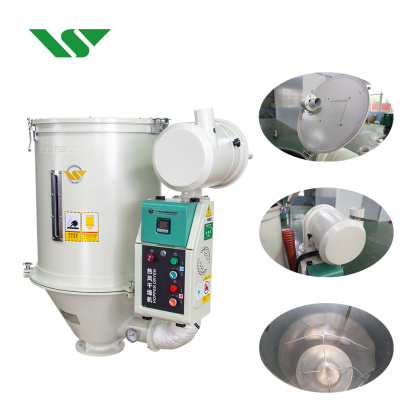Comprehensive Guide to Plastic Dryer Types: How to Cut Production Costs by 30%
2025-03-27 Page view:
Are you facing issues like surface bubbles on injection-molded products or inconsistent dimensional accuracy? It’s crucial to address drying problems, as 80% of production defects are due to improper drying. In this article, we’ll break down the six main types of plastic dryers, explore their technical advantages, and show you how choosing the right dryer can reduce annual material losses that could otherwise reach millions.

I. The Consequences of Choosing the Wrong Plastic Dryer
1. Energy Inefficiency
Hot-air dryers, often used in many production lines, contribute to about 25% of total energy consumption, leading to unnecessary costs.
2. Quality Risks
Even a small amount of excess moisture (0.02%) in engineering plastics such as PA or PC can significantly impact the product’s strength, decreasing it by as much as 40%.
3. Hidden Long-Term Costs
While stainless steel dryers come with a 15% higher upfront investment, they offer a remarkable 60% reduction in maintenance costs over a 5-year period, proving to be more economical in the long run.
II. A Technical Breakdown of Plastic Dryer Types
Hot Air Circulation Dryers – The Budget-Friendly Option
Structure: The standard combination of iron barrels and finned heating tubes is a reliable choice for smaller manufacturers.
Key Limitation: Drying PET material becomes inefficient, with drying time increasing 2.3 times when humidity levels rise above 70%, based on field test data.
Best Use: Ideal for low-hygroscopic materials like PP and ABS, as long as moisture content standards are strictly followed.
European-Style Dryers – The "Premium" Option
304 Stainless Steel Realities: A 1.2mm wall thickness offers up to 8 years of service life compared to the 0.5mm variety.
Airflow Efficiency: Techniques can be applied to minimize temperature discrepancies between the center and edge of the drying chamber, reducing variance from ±8°C to just ±2°C.
Maintenance Tips: These dryers require seal replacements every 2,000 operating hours to maintain efficiency, which should be factored into the overall cost analysis.
Optimizing Energy Efficiency in Dryers
Dual-Layer Insulation: This simple upgrade has been proven to reduce energy consumption by 37%, as verified through meter data from an automotive parts manufacturer.
PID Control System: By reducing frequency during nighttime operation, manufacturers can save up to 8,000 kWh per year.
Safety Features: New air duct designs keep the surface temperature at a safe 40°C, preventing burns and safety risks for operators.

III. How to Choose the Right Plastic Dryer: A Simple 3-Step Guide
Step 1: Material-Based Selection
Biodegradable Plastics: Opt for desiccant dryers, which require a dew point of -40°C or lower for effective moisture removal.
Glass-Filled PA: Microwave dryers are best for these materials to prevent damage to the fibers during the drying process.
Step 2: Calculate Your Required Capacity
To determine the ideal dryer size, calculate equipment volume by multiplying hourly consumption by the drying time needed, plus an additional 1.5-hour safety buffer.
Step 3: Cost-Benefit Analysis
Case Study: A household goods manufacturer recouped their initial investment within 2 years after switching to energy-efficient dryers.
IV. Essential Maintenance Practices for Extending Dryer Life
1. Hot Air Filter Maintenance
Never use compressed air for cleaning filters. Watch a video demonstration on the correct way to flush filters to maintain optimal performance.
2. Molecular Sieve Replacement
If the outlet temperature rises by 5°C, it’s time to replace the molecular sieve immediately to prevent downtime and production losses.
3. Emergency Procedures
Learn the three critical steps you need to take to prevent material agglomeration in case of a power outage.

2024 Industry Insights
Precision drying systems have been shown to reduce defect rates by 12-18%. If you're dealing with issues like PVC discoloration or silver streaks in POM, reach out to our Wensui engineering team for free custom upgrade proposals to optimize your production line.



